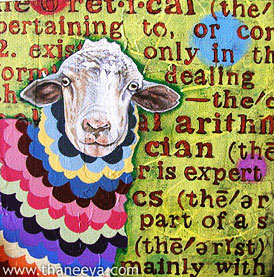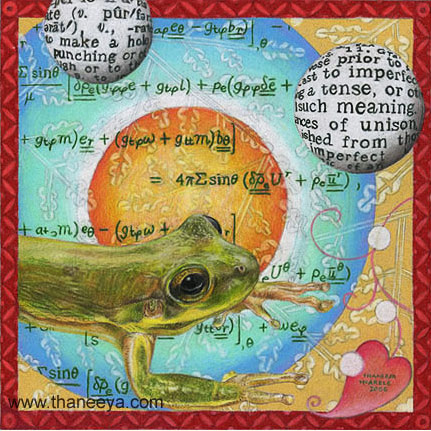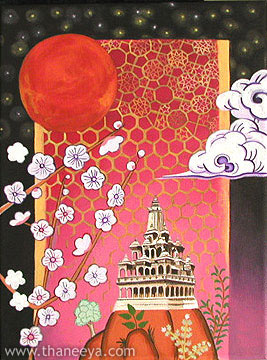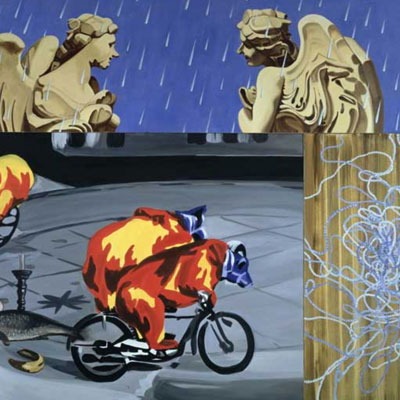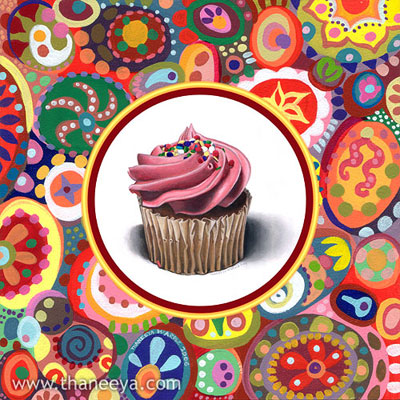Creative art style: composite
This style of creative art combines a variety, or composite, of different styles. For instance, what happens when you combine abstract art with photorealist art? Visually, they are about as utterly different as you can get. One is based on formal qualities like line, pattern and color, whilst the other seeks to replicate photographic detail. When combined, they can play off each other to create a compelling visual and intellectual dynamic. To see what I mean, take a look at my funky sheep painting below, and my other composite artwork on this page!
Combining Imagery
Combining different styles of art can lead to a different spin on reality and perception. Composite art therefore contains many layers of meaning. By combining a variety of imagery, and/or different styles of art, it is possible to forge creative connections between otherwise disparate ideas or themes. Through art, you can unite a sparrow with Beethoven, or a frog with black holes, or myriad other interesting combos!
Composite artwork has the potential to be fresh and innovative. Because there are so many potential combinations of images and styles, the possibilities are endless. Within my own body of work, I classify these types of paintings and drawings as "Composite Realism", because they involve elements of intense realism combined with abstract patterns and forms. This is a great way to interweave arcane concepts such as philosophy, the depths of time, the mystery of memory, and the assorted pursuits of science (to name just a few!) with more easy imagery, such as cows, fish, or cupcakes. What fun!
The creativity of composite artwork lies in unexpected juxtapositions of different elements. Familiar images can be enlarged, cropped, shrunk, distorted, or arranged in surprising ways that redefine the meaning of the objects depicted. The habitual meanings we assign to objects suddenly become more fluid, more changeable, even more elusive. In other words, everyday images are recontextualized - given a new life.
Let's see an example:
This frog drawing is an example of one of my Composite Realism pieces. This drawing combines a photorealist rendering of a frog with abstract patterns, black hole equations and dictionary definitions. This elaborately detailed drawing is part of my Deep Thinkers series, in which various animals are juxtaposed with evidence of human thought, in the form of mathematical equations, quotes, definitions, musical scores, etc. These pieces depict a zen-like transcendent bridge between conceptual thinking and animalistic consciousness. These two contrasts are united by a careful use of color and decorative design.
What does it mean?
The overall meaning of this piece is entirely up to the viewer. The poetic beauty of composite art is that it allows for free association. Because the normal context of these images dissolves, you can create your own context and weave your own story around the images.
Composite art speaks to a contemporary world that is continually bombarded by a neverending flood of images, ideas, and information. We currently inhabit a world that is overflowing with constant streams of information that beam into space, bounce off of satellites and encircle the globe. Information can spread across continents in a matter of milliseconds. Our world is a constant influx and exchange of energy. These images and ideas overlap and superimpose over one another on the artist's canvas in the same way as they co-exist in our collective consciousness.
In a nutshell, composite artwork has the ability to surprise, delight, enlighten and tickle your brain cells. Composite art represents a new way of finding wholeness and unity. It is a form of creative art that can dissolve boundaries and limitations, propose new possibilities, embrace multiple viewpoints and introduce novel ways of story-telling.
Noteworthy artists who work in a composite style:
David Salle
David Salle is an American painter whose creative art paintings combine a multitude of different images. For instance, his painting Angels in the Rain combines angel statues, performing bears and abstract elements. His painterly style is like a visual collage.
James Rosenquist
James Rosenquist is an American painter with close ties to the Pop Art movement. Rosenquist combined abstraction and painterly realism to create a series of large-scale paintings addressing pop culture, consumerism/commercialism, and modern history. Due to the large scale of these paintings, as well as the way he handles the paint, his representational images often become abstract - such as the spaghetti in his creative art paintings, I Love you with my Ford or F-111.
Thaneeya McArdle
Thaneeya McArdle (that's me!) is a contemporary American artist who works in a composite realism style, often combining photorealistically-rendered images of animals with abstract backgrounds.
Tips for creating your own Composite Art
Make a collage first. Arrange and rearrange images that interest you. Cut out familiar images in such ways that they become unrecognizable, or abstract. Use fragments of images. (If you use images from magazines, be sure to familiarize yourself with copyright laws for collage artists.)
Exercise: cut out a familiar object from a magazine, then cut it again until there is only a small recognizable fragment left. Or you can continue cutting it until it becomes completely unrecognizable and abstract.
Learn more about patterns in art. Research patterns that you like. Search for copyright-free patterns. Create your own patterns. Combine your patterns with other imagery - for example, you can place a pattern on top of, next to, underneath or behind a realistic image.
Add text. Paint or draw on top of a book page.
Use Photoshop or some other photo-editing program to overlap and juxtapose images. You can play with bringing different elements to the foreground or background. Photoshop is a great way to play with ideas and get the ball rolling.
Overlap images. Play with translucency vs opacity. Translucent images allow some of the imagery underneath to show through, whereas opaque imagery is solid and you can't see through it.

